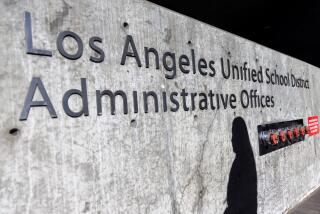Dealing With Danger
- Share via
The small blast sounded to Rick Gale as if a firecracker had gone off in a nearby classroom. Walking to the administration building at Woodbridge High School in Irvine, the social science teacher turned to make sure that no one was hurt.
All he saw was a substitute teacher chatting with students at the room’s entrance, causing him to believe the situation was under control. Only later that day in 1993 did Gale find out that a student had fired a gun into the floor. Neither the teacher nor students had reported the shooting, possibly fearful or overwhelmed by the situation.
It’s a classic scenario that Gale and Eric S. Bianchi, an Irvine police officer, hope to prepare teachers for, in the hopes that educators will handle dangerous situations with more confidence.
After years of giving presentations on ways to create a safer campus environment to parents, teachers and police officers all over California, the duo have set up a nonprofit organization called Safe Campus Strategies to bring their message to those in the trenches.
“Our goal is to reduce teachers’ anxiety by teaching them to prepare,” said Gale, 51, a 25-year teacher.
In addition to teaching social science at Woodbridge High, Gale is a retired reserve officer with the Irvine Police Department and a crisis negotiator for the National Park Service. His classroom walls are decorated with his bulletproof vest and a collection of baseball caps from police departments across the country.
“We provide a toolbox that [teachers] can reach into so that teachers and students are safe,” Gale said. “As educators, there’s not a lot there to prepare you for a situation in the classroom, and that’s what we look at.”
The idea to bring structure to their work came as requests for seminars rose during the last year.
“Demand started to increase after Columbine,” said Bianchi, who is a member of the Irvine police’s special operations unit.
While both men can draw on many years of firsthand experience--Bianchi, 48, has worked as a police officer for 24 years--they said they don’t see themselves as experts on dealing with violence in schools. “All we’re doing is presenting material that we feel is important based on our experience,” Bianchi said.
Their recent presentations included workshops at Montana State University and the University of Phoenix. Although the duo don’t charge for their services, they said stipends from clients support their work.
In the spring, they held a workshop for about 100 teachers and administrators at the Coastline Regional Occupation Program. They will hold another workshop this month at Silverado Continuation High School in the Saddleback Unified School District.
Patricia Clark White, superintendent of the Irvine Unified School District, has asked Bianchi and Gale to help develop a training program for all district employees.
The program also has supporters in the Orange County Department of Education, where administrators plan to bring it to the attention of the county’s 26 school districts.
“Most children feel that school is a very safe place to be,” said Nancy Hugo, who coordinates federal and state drug and violence prevention programs for the department. “When an incident does occur, there needs to be support.”
Bianchi and Gale’s presentation could help clarify the roles of educators and police officers when violence occurs at a school.
Some of the tips are simple, such as remembering to dial an extra 9 to get an outside line when calling 911 in an emergency. Other ideas the men have shared with teachers are making ID cards that list each teacher’s specific duties during disasters and giving cell phones to teachers who work late at otherwise-deserted school sites.
“The teachers walk away liberated,” he said, “because they got a plan.”
But the main thrust of the presentations is to persuade teachers not to ignore violence or the potential for it, he said.
For all their concern about safe schools, the two men do not recommend extreme measures. Drastic steps such as fencing in an entire campus can prove counterproductive, Gale said.
“You have to be careful not to create an atmosphere of an armed camp,” Gale said. “I don’t want to teach at an armed camp.”
Their own stories lend credibility to their suggestions, Gale said. Before one particular presentation, he had helped one of his students deal with a stalker. The girl had told Gale that a student from a different school had been pursuing her, and Gale contacted the Police Department to follow up on the incident.
While a Web site (https://www.safecampus.org) and polo shirts with the organizations’ name remain the only novelties in Gale and Bianchi’s work, they said they hope to write a book, produce a training video and establish seminars to deal with the aftermath of disasters at schools as well.
*
COMING MONDAY
* Safety Zone looks at safety on our college campuses.
More to Read
Sign up for Essential California
The most important California stories and recommendations in your inbox every morning.
You may occasionally receive promotional content from the Los Angeles Times.













